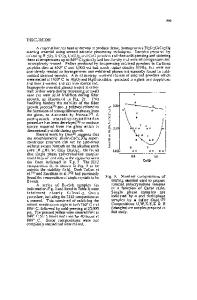Influence of Bi-site Substitution on the Ferroelectricity of the Aurivillius Compound Bi 2 SrNb 2 O 9
- PDF / 217,226 Bytes
- 7 Pages / 612 x 792 pts (letter) Page_size
- 20 Downloads / 307 Views
MATERIALS RESEARCH
Welcome
Comments
Help
Influence of Bi-site substitution on the ferroelectricity of the Aurivillius compound Bi2 SrNb2 O9 P. Dur´an-Mart´ın, A. Castro, P. Mill´an, and B. Jim´enez Instituto de Ciencia de Materiales, CSIC. Cantoblanco. 28049-Madrid, Spain (Received 17 July 1997; accepted 1 December 1997)
Ceramics based on the composition Bi2 SrNb2 O9 with isomorphic substitutions of cations in the Bi2 O2 21 and the perovskite layers, Bi22x Tex Sr12x Na(K)x Nb2 O9 , have been prepared by solid state reaction. The ferroelectricity of this Aurivillius type structure has been studied. Dielectric measurements as a function of the temperature show a low temperature maximum in the dielectric constant that would correspond to a ferro-paraelectric phase transition. The temperature of this maximum increases when the radius of the ion that substitutes Sr for decreases. A second maximum in the dielectric constant is found at higher temperature possibly corresponding to a relaxor ferroelectric. Measurements of remanent polarization as a function of the temperature seem to confirm the relaxor behavior, because the polarization disappears at temperatures between the two maxima of the dielectric constant. Saturated hysteresis loops are obtained for all the substituted samples at temperatures above 300 ±C. Ferroelectric parameters such as the polarization, coercive field, and coupling factors of the BSN family compounds were obtained for the first time. The ac electric conductivity shows anomalies at temperatures close to those where the remanent polarization disappears. Activation energies calculated from measurements of dc electric conductivity, impedance arcs, and dielectric modulus data may be associated with thermally activated oxygen vacancies.
I. INTRODUCTION
Aurivillius type structure oxides are generally formulated as Bi2 An21 Bn O3n13 and consist of n-perovskite layers [An21 Bn O3n11 ]22 sandwiched between bismuthoxygen sheets [Bi2 O2 ]21 .1 More recently we have reported the possibility of substitutions into the Bi-site of the bismuth oxide layer by other p-cations that have a stereochemical active lone pair of electrons, such as Pb21 , Sb31 , and Te41 .2–5 The particular case of Te41 substitution gives rise to an increase in the electric charge of the [(Bi, Te)2 O2 ] layers that can be compensated by three different ways: substitution in the Bi-site,3 or substitution in the A or B sites of perovskite-like layers.5 It is well known that the Aurivillius composition of Bi2 SrNb2 O9 6 has ferroelectric behavior at room temperature with an orthorhombic to tetragonal phase transition at 420 ±C, where a strong anomaly in the dielectric constant is observed. In the Sr-site substituted compositions there is a variation of the phase transition temperature with the ionic radius size and the amount of modifier, but no extra peaks in dielectric constant have been observed.6 Many works in literature have reported the existence of other n 2 bismuth layer compounds that exhibit two phase transitions widely sep
Data Loading...











